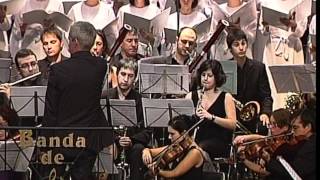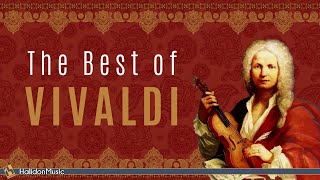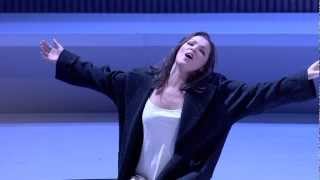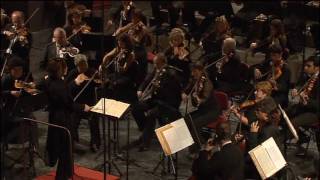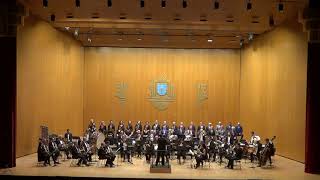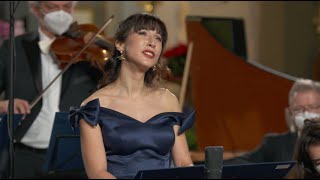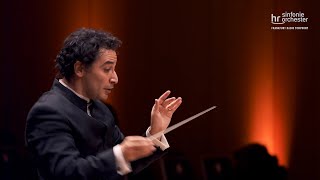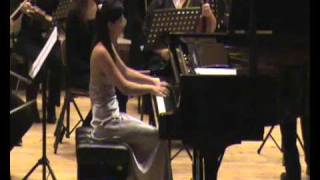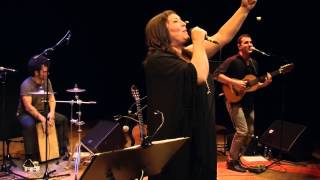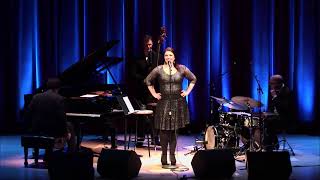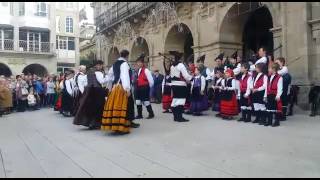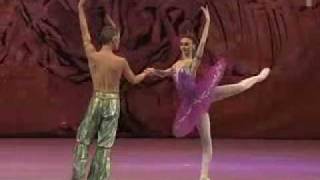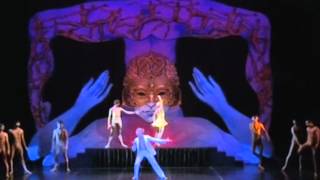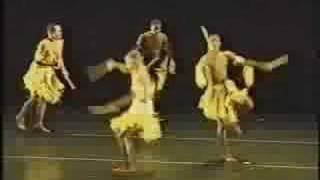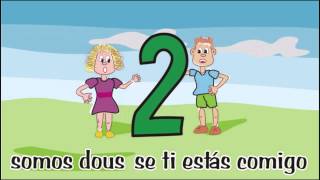On July 25, Galician Homeland Day is celebrated
Recommended music videos for initiation to classical music
Xoán Montes (1840-1899) was a Galician composer, instrumentalist and teacher born in Lugo . In 1850 he began his studies at the Lugo Council Seminary in order to pursue a priestly career. He will spend fourteen years training as an intern at the ecclesiastical institution, leaving it in the summer of 1864 to dedicate himself entirely to the practice of music. During his years as a seminarian, Montes received very little musical training that he himself would need to continue in a self-taught way, studying the texts of Fetis-Gil, Eslava or Berlioz . In Montes ' production we find compositions and arrangements for choir, organ, band, orchestra, quartet, sextet, voice or piano. He died on the night of June 23-24, 1899 due to a brain hemorrhage.
Negra sombra is a Galician poem by Rosalía de Castro set to music by Xoán Montes and converted by him into one of the most emblematic Galician songs. Today it is offered to us by the Orfeón Donostiarra with the Orchestra of the Kingdom of Aragon, all conducted by maestro José Antonio Sáinz Alfaro .
Antonio Vivaldi (1678-1741) was an Italian priest, violinist, and composer known as the red priest (“il prete rosso”). He was born in Venice and as a child learned to play the violin from his father; at the age of 15 he entered the Seminary and once ordained a priest, he could barely attend to his religious obligations due to his health problems; so he was appointed violin teacher in an orphanage where he taught theory and instrument classes. At the age of 40 he was appointed Kapellmeister in Mantua where he wrote his famous "Four Seasons" which are four violin concertos. From there he moved to Milan , then to Rome ; later, again to Venice and finally, to Vienna where he would die. Throughout his life he composed almost 800 works, of which half were concerts, 40 operas, 60 religious works and numerous sonatas.
The Best Works of Vivaldi 1 (0´0´´) THE FOUR SEASONS: "SPRING": I. ALLEGRO .-. 2 (3´33´´) THE FOUR SEASONS: "SPRING": II. LONG .-. 3 (6´22´´) THE FOUR SEASONS: "SPRING": III. ALLEGRO PASTORALE .-. 4 (10´27´´) THE FOUR SEASONS: "SUMMER" : I. ALLEGRO .-. 5 (16´24´´) THE FOUR SEASONS: "SUMMER": II. ADAGIO E PIANO .-. 6 (18´35´´) THE FOUR SEASONS: "SUMMER": III. PRESTO .-. 7 (21´33´´) THE FOUR SEASONS: "AUTUMN": I. ALLEGRO .-. 8 (26´34´´) THE FOUR SEASONS: "AUTUMN": II. ADAGIO MOLTO .-. 9 (28´58´´) THE FOUR SEASONS: "AUTUMN": III. ALLEGRO .-. 10 (32´24´´) CONCERTO FOR TWO HORNS RV 538 – ALLEGRO .-. 11 (35´09´´) CONCERTO FOR TWO TRUMPETS - MOVT 1 .-. 12 (38´20´´) CONCERTO FOR TWO TRUMPETS MOVT 2 .-. 13 (39´12´´) CONCERTO FOR TWO TRUMPETS MOVT 3 .-. 14 (42´41´´) CONCERTO FOR TWO VIOLINS & TWO CELLOS - ALLEGRO .-. 15 (46´55´´) CONCERTO FOR TWO VIOLINS & TWO CELLOS – LONG .-. 16 (49´ 16´´) CONCERTO FOR TWO VIOLINS & TWO CELLOS – ALLEGRO .-. 17 (52´39´´) CONCERTO GROSSO RV 562A - ALLEGRO .-. 18 (58´07´´) FLUTE CONCERTO OP.10 - MOVT 1 .-. 19 (1H 2´22´´) FLUTE CONCERTO OP.10 - MOVT 2 .-. 20 (1H5´04´´) FLUTE CONCERTO OP.10 - MOVT 3 .-. 21 (1H8´17´´) SYMPHONY NO.1 IN C RV 116 – I ALLEGRO .-. 22(1H11´04´´) SYMPHONY NO.1 – II ANDANTE .-. 23 (1H14´15´´) SYMPHONY NO.1 – III PRESTO .-. 24 (1H15´24´´) LUTE CONCERTO - ALLEGRO .- 25(1H 19´37´´) LUTE CONCERTO - ANDANTE .-. 26 (1H24´44´´) LUTE CONCERTO – ALLEGRO .-. 27 (1H28´19´´) BASSOON CONCERTO RV489 - ALLEGRO .-. 28 (1H31´45´´) CONCERTO FOR TWO OBOES - ALLEGRO .-. 29 (1H34´26´´) LUTE CONCERTO
Giuseppe Verdi (1813-1901) was an Italian composer; he wrote 28 operas considered as a bridge from bel canto to verismo . He was born in Le Roncole near Busetto; As a child he belonged to the Church choir where he received organ lessons and at the age of ten his parents enrolled him in the Busetto School of Music , where he received the unconditional support of patron Antonio Berezzi . Supported by Berezzi , at the age of 19 he moved to Milan where he continued his studies, after which he returned to Busetto as a music teacher and where he married Berezzi 's daughter. In his youth he sympathized with the popular movements that demanded the unity of an Italy divided by different European dynasties. To the point that they chanted “Viva Verdi” with the double meaning of Viva V ittorio E manuele R e D ' Italia .
La Traviata , an opera by Verdi structured in three acts, is, along with Aida and Rigoletto (also operas by Verdi ), one of the most appreciated operas of the world lyric genre and one of the most performed; its plot is based on the novel by Alexandre Dumas The Lady of the Camellias and it premiered in Venice on March 6, 1853. Today we can watch the aria Addio del passato in which Violeta , seeing her death close, deplores her perverted life and the loss of his love.
Ana Netrebko (1971), is a Russian singer and one of the most brilliant sopranos in history. He began as a janitor at the Mariinsky Theater until he was heard by the conductor Valery Gergiev who became his adviser, beginning to play roles of some relevance in various operas. At the age of 24 he made his debut in the USA where the successes were chained one after another after his appearance at the San Francisco opera. Claudio Abbado also played a relevant role in his dedication to the bel canto repertoire, while his technique was perfected with the Italian soprano Renata Scotto .
Johannes Brahms (1833-1897) born in Vienna , where he spent most of his life, was the composer of the most conservative romanticism against the progressive current led by Liszt and Wagner . His music is firmly rooted in the compositional structures and techniques of the classical masters and its formal structures faithfully follow the patterns of classicism , although it uses some of the coloring of romanticism and popular music . Of an eminently perfectionist nature, he wrote for piano, chamber ensembles, symphony orchestra, for solo voices and for choir. It was Hans von Bulow who proposed the "three B's" referring to Bach , Beethoven and Brahms as the three main pillars of the History of music .
Brahms's Hungarian Dances are a set of twenty-one joyous dances, mostly based on Hungarian themes, composed in 1869, although dances 11, 14, and 16 are original; Its duration ranges from one to four minutes. Brahms originally composed them for piano four hands, and later arranged ten of them for piano solo, and a few others (numbers 1, 3, and 10) for orchestra. Various composers have orchestrated the rest; in particular, Antonín Dvořák , who on the other hand, was inspired by them to compose his series of Slavic Dances .
Brahms's Hungarian Dance No. 1 was originally composed for piano four hands and later orchestrated by the same author. Today we present the version made by the Budapest Philharmonic under the baton of the teacher
Tomomi Nishimoto (1970) who began her piano studies at the age of three at the hands of her mother. Following the completion of her Bachelor of Music in Composition from the Osaka College of Music in 1994, Nishimoto was admitted to the Saint Petersburg State Conservatory. Although she had experience conducting opera during her years at the Osaka College of Music as deputy conductor, her formal conducting career began in 1998 with the Kyoto Symphony Orchestra , while her professional career in Russia began in 1999, when she conducted the San Antonio Philharmonic. Petersburg ; from 2010 to 2011 she was the Principal Guest Conductor of the Russian State Symphony Orchestra and has subsequently conducted numerous major European orchestras.
Recommended classical music videos
Andrés Gaos Berea (La Coruña 1874 - Mar del Plata 1959) was a Galician musical educator, composer and violinist. He studied with the violinist Eduardo Dorado and upon finishing his primary studies, the Provincial Council of La Coruña gave him a pension to study violin in Madrid and Brussels . In the summer of 1895 he arrived in Buenos Aires where he met his future wife, the singer and violinist América Montenegro , with whom he had five children. Divorced in 1917, he married his student Luisa Guillochon with whom he had another three children and after eight years in France , he returned to Buenos Aires as a state education inspector. His compositional work was mainly oriented towards various genres of popular music (songs, dances, works for institutional competitions), chamber, theater and symphonic music.
The Second Symphony , En las montañas de Galicia , is composed by unidentified authors based on original materials by Andrés Gaos after the composer's death. Today we offer his first movement in a version of the Santiago de Compostela Municipal Music Band conducted by maestro Casiano Mouriño .
The Motet (from the French motet, and this one from mot: 'word, nickname') is a polyphonic composition born in the 13th century to be sung in churches with commonly biblical themes. These were songs for religious worship for 4 voices in Latin and " a cappella " (without instruments). Until the 17th century it was one of the most important musical forms of polyphonic music. From the Baroque period (1600-1750) the word motet was also applied to sacred compositions written for one or several voices with instrumental accompaniment.
Nulla in mundo pax sincera , RV 630, is a sacred motet composed by Antonio Vivaldi in 1735, with a Latin text by an unknown author. The title can be translated as "In this world there is no sincere peace" . Written in the key of E major and in typical Baroque Italian lyric style, it is scored for a solo soprano and instrumental accompaniment of two violins, viola, and basso continuo (usually performed by a cello and keyboard instrument). it describes the imperfections of a world full of evil and sin, and praises Jesus for the salvation he offers. This motet is considered one of the most beautiful by Vivaldi , on this occasion offered by soprano Marie Lys , accompanied by I Cameristi della Scala conducted by maestro Giulio Prandi .
Felix Mendelssohn (1809-1847) was a German pianist, conductor and composer of outstanding technical and formal perfection. Child prodigy who at a very early age showed his extraordinary abilities and brother of the pianist and composer Fanny Mendelssohn , also a child prodigy. He began by receiving piano lessons from his mother; At the age of eighteen, he entered composition classes based on Bach 's Well-Tempered Clavier . In this way, Mendelssohn 's works show a well-established tonal clarity and a deep mastery of counterpoint. His legacy includes piano music, organ music, chamber music, overtures, symphonies, concertos, oratorios, and incidental music.
Symphony No. 3 in A minor op. 56, known as the Scotch , is a symphony by Felix Mendelssohn composed between 1829 and 1842. Mendelssohn was inspired to compose this symphony during his first visit to Britain in 1829. “In deep twilight we went today to the palace where the lady lived and loved. Queen Mary ... The chapel below now has no roof; grass and ivy thrive there and on the broken altar where Mary was crowned Queen of Scots . Everything is ruined, decayed, and the clear skies pour down. I think I have found the beginning of my Scottish Symphony there." It is not known exactly when Mendelssohn resumed work on the symphony, but it is certain that he was working seriously on the work in 1841 and completed the symphony in Berlin on January 20, 1842.
structure . It consists of four interconnected movements; Unusually, Mendelssohn marked the movements to be executed without interruptions and underlined the connection between the parts of the symphony making them grow from the continuous thematic transformation of the original idea that he had noted down in 1829: I (0´18´´) ANDANTE CON MOTO .-. II (17´03´´) VIVACE NO TROPPO .-. III (21´14´´) ADAGIO .-. IV (30'52'') ALLEGRO VERY VIVACIOUS.
The version that we offer today corresponds to the Galician Symphony conducted by the British maestro Rumon Gamba ( 1972) .
César Franck (1822–1890) was a Belgian-born French composer and organist. His family settled in Paris at the beginning of 1835, when César entered his Conservatory at the age of fourteen. In 1872 he was appointed organ professor at the Conservatory . If his oratorio Les béatitudes had occupied him ten years (1868-78), in this new period each summer he concludes a new masterful composition. In 1882, The cursed hunter ; in 1884, the Prelude, choral and fugue and The Djinns ; in 1885, the Symphonic Variations ; in 1886, the Sonata for violin and piano ; in 1887, Prelude, aria and finale ; in 1888, Psyché and the Symphony in D minor ; in 1889, the String Quartet ; in 1890 the Three choirs for organ , which would constitute his authentic musical and spiritual testament.
The cyclical form is a musical construction technique by which a theme, melody, or thematic material is used as a unifying element of various sections or movements of a musical composition. Sometimes the theme appears at the beginning and at the end; for example, in Brahms 's Symphony No. 3 . At other times it may appear in different parts, such as in Berlioz 's Symphony of the Fantastic . The term is usually applied to music composed from the 19th century , and among the most famous cases are Beethoven 's Symphony No. 5 , César Franck 's Symphony in D minor or Berlioz 's Symphony of the Fantastic , as well as the Sonata for piano in B minor and numerous other compositions by Franz Liszt .
The Symphonic Variations , M. 46, is a work for piano and orchestra written in 1885 by César Franck . It has been described as "one of Franck's most complex and complete works" and "an impeccable work and as close to perfection as a human composer can hope to achieve". It is a good example of Franck 's use of cyclical unity, with one theme growing into several others and with piano and orchestra sharing the development of ideas equally.
Today's version corresponds to Petya Hristova on piano with Martin Klepetko as conductor.
Recommended music videos for all tastes
Uxía (1962) is a Galician singer, who started singing at a very young age. His career officially began in 1985, when he won the first prize at the Bergantiños Festival . In 1986, when he was only twenty-four years old, he published his first album, Foliada de Marzo , with music quite close to the traditional. He represented Galician Television in 1991 at a regional television festival held in Nuremberg and Galicia at Expo 98 in Lisbon and at Liet International , at the most important music festival for minority languages, which was held in Ljouwert in 2004, and where the mosense was third. In 2017, he was awarded the Rebulir da Cultura Galega Award, in recognition of his personal and professional career in the dissemination and enhancement of Galician music.
Justin Timberlake (Memphis 1981) is an American singer, songwriter, producer, actor, dancer, and businessman. At the end of the 1990s, he gained international fame by belonging to BoyBand 'N Sync , whose first two albums were certified with a diamond disc after selling more than 10 million copies in the USA alone, in addition to having reached the top of numerous lists around of the world. After announcing that BoyBand 'N Sync would temporarily break up, Timberlake began a solo career. Throughout his career he has been recognized with ten Grammy Awards , seven American Music Awards , three Brit Awards , four Emmy Awards , eleven MTV Video Music Awards and ten Billboard Music Awards , as well as one Oscar Award nomination and two Golden Globes .
Jane Monheit (1977) is an American jazz singer, who has received Grammy nominations for two of her records. In 1999, he graduated with honors from the Manhattan School of Music , earning a BA in music and receiving the William H. Borden Award for Outstanding Achievement in Jazz . In 1998 he spent most of the year on tour with his band, although he also performed with major symphony orchestras. Monheit has released ten albums and two DVDs, and has appeared as a guest artist on many different television shows. On her latest album, Jane Monheit pays homage to one of the great ladies of jazz with The Songbook Sessions : Ella Fitzgerald , a project directed, arranged and produced by Nicholas Payton .
The Beach Boys is a rock band formed in Los Angeles (California) in 1961. Distinguished for their vocal harmonies, they are one of the most influential groups of the rock and roll era. The group, led by its primary songwriter and producer Brian Wilson , pioneered new approaches to popular music, drawing on 1950s jazz and rock and roll to create their unique sound. Later he arranged his compositions for studio orchestras and explored a wide variety of styles, incorporating unconventional recording techniques. Nicknamed "America's Beatles" , The Beach Boys were frequently cited as America 's greatest musical group and in 2011, Rolling Stone magazine ranked them at number 12 on its "100 Greatest Artists" list.
Recommended peculiar videos
The muñeira (in Galician, muiñeira: "molinera") is a popular dance of Galician origin that is danced in Galicia and in the Spanish autonomous communities of Asturias and in territories of Castilla y León bordering Galicia . According to Dionisio Preciado , in other regions of Spain it is called "gallegada". cunchas or scallops). There are no unequivocal documentary references to the doll prior to the 16th century . At present it is, above all, an instrumental dance that maintains a beatable rhythm in 6/8. The name muiñeira evokes the days of work in the mills -in Galician muíños- and the leisure associated with waiting for the grinding.
Adolphe Adam (1803-1856) was a French composer born in Paris and author of abundant stage music. He was the son of the renowned pianist and professor at the Paris Conservatoire , Lois Adam , with whom he began his musical studies. His first successes came to him in his adulthood with the ballet Giselle and the opera Si j'étais roi ; by then he had already written several ballets and operas. In total he wrote 40 operas, 14 ballets and various cantatas, hymns, masses, choirs, piano pieces, pantomimes, military marches and plays; Of all these compositions, it is worth noting, in addition to those already mentioned, the ballet Le Corsaire and the worldwide known Christmas carol Cantique de Noël , in its English translation, as O Holy Night .
Pas de deux (in Spanish, step for two) is one that is performed jointly by two people. It usually consists of an entrée (couple's entrance), adagio , two variations (one for each dancer, usually an allegro ), and a coda . It is also known as Grand pas de deux (Great pas de deux).
Today we offer the Pas de deux belonging to the ballet in three acts, Le Corsaire , starring the Ukrainian Svetlana Zajárova (1979) and the Russian Igor Zelensky (1969) considered both as some of the most important dancers of their generation.
Carl Orff (1895-1982) was a German composer, whose work can be framed within the current of musical neoclassicism . He was known for his work Carmina Burana , from the triptych of scenic cantatas to which Catulli Carmina and the Triumph of Aphrodite also belong; His name has also been universally disclosed for developing a musical teaching system for children (known as the Orff method ) that has had notable results. Orff began playing the piano at the age of five, and also took organ and cello lessons. However, he was more interested in the composition; so from an early age Orff wrote and staged puppet plays for his family, with music for piano, violin, zither, and glockenspiel to accompany his plays.
Catulli Carmina (Songs -or Words- of Catullus ) is a scenic cantata composed by Carl Orff , premiered in 1943 in Munich and based on the texts of the Latin poet Gaius Valerius Catullus (84-54 BC). It is written for two soloists, a mixed choir, a large percussion group and four pianos. The work experiments with the repetition of phrases and syncopated rhythms, along the lines already used in Carmina Burana, taking this game even further. Today we present the Ballet choreographed by Mai-Ester Murdmaa (Estonia).
The maculelé is a folk stick dance of Afro-Brazilian origin, where a number of people gather in a circle called the roda . Some sticks called grimas and some skirts made of dry herbs are needed. To dance a circle of people is formed; each person carries a pair of long chopsticks, traditionally made from the wood of the Brazilian biriba; the people in the circle begin to bump the sticks against each other rhythmically; the leader sings and the people in the circle respond by singing to the refrain of the songs. The leader gives the signal to start the dance. It seems that the origin of the dance begins in slavery-era Brazil , where slaves on sugarcane plantations would gather and dance the maculelé to express their anger and frustration at being slaves.
Recommended music videos for children
Various Wikipedia articles have been used to write these texts.
The texts of Videomusicalis are written in Basque, Spanish and English.





